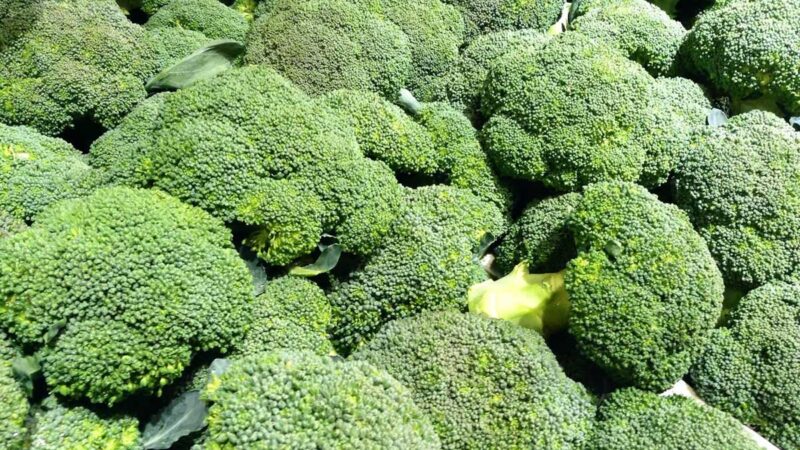Broccoli is bursting with vitamins such as vitamin C, vitamin K, and vitamin A which are good for your immune system and bones, and has antioxidants that can protect against cancer. It is high in fibre, which is good for digestion and helps keep you full, while being low in calories, which is good for weight loss. In addition, broccoli contains substances that can reduce inflammation, which is good for the body's overall health. It's also a versatile vegetable that can be prepared in many healthy and tasty ways. In this section, we dive into why broccoli is healthy for you and how many different types there are
Table of contents
ToggleThe Health Benefits of Broccoli: An Underrated Super Vegetable
The Countless Health Benefits
Broccoli is a source packed with vitamins C, K, A and folate, as well as essential minerals like calcium and potassium. Its rich fibre content supports good digestion and may contribute to better heart health. Powerful antioxidants like sulforaphane protect against cell damage and inflammation, which may reduce the risk of cancer and heart disease. Broccoli is also beneficial for the eyes, bones and skin, making it a versatile vegetable to keep the body healthy.
Can broccoli prevent against vigour?
Research shows that broccoli contains sulforaphane, a compound that is effective against prostate, breast, colon and mouth cancer. In addition to sulforaphane, it also contains vital folate, dietary fibre and antioxidants such as carotenoids and vitamin C, which support general health and prevent inflammatory and cardiovascular diseases.
Studies confirm that a high intake of vegetables reduces the risk of genetic diseases. Eating vegetables regularly can potentially reduce the risk of heart disease and digestive diseases by over 50% This is mainly due to the substance sulforaphane, which is found in the plant. Sulforaphane is a potent antioxidant that has been shown to have cancer-preventing properties in laboratory studies.

Which type of broccoli has the most sulforaphane?
Sulforaphane (Glucosinolates) is a sulfur-containing compound found in cruciferous vegetables, including broccoli and cabbage plants. Research has shown that this compound has the potential to fight various diseases, including cancer.
Among the many different varieties, the budding Broccoli Calabrese, also known as sprouts, or micro green, that contain the highest amount of sulforaphane. These sprouts are typically 3-4 days old (as microgreens 7-10 days) and contain sulforaphane concentrations that are significantly higher than in fully grown broccoli plants.
In addition, research shows that cooking also affects the amount of sulforaphane. Raw broccoli tends to contain more sulforaphane than cooked, as heat treatment can break down some of the compounds that are converted to sulforaphane. So to maximize the intake of sulforaphane, it may be a good idea to include raw sprouts and microgreens of it in your diet.
How do I maximize the content of sulforaphane?
To maximize the content of sulforaphane, there are several methods you can use:
- Choose Broccoli Sprouts: Contains the highest concentrations of glucoraphanin, which is the precursor to sulforaphane. These can be eaten raw in salads and as a spread.
- Choose Broccoli microgreens: Also contains one of the highest concentrations of glucoraphanin, the precursor to sulforaphane. The microgreen version can be eaten raw in salads or as a spread.
- Eat it Raw: As heat can break down glucoraphanin and the enzyme that converts it to sulforaphane, it's best to eat it raw if you want to maximise the sulforaphane content.
- Cut in advance: If you prefer to eat your broccoli cooked, cut it into smaller pieces and let it rest for about 40 minutes before cooking it for a short time. This allows the enzyme myrosinase to begin the conversion of glucoraphanin to sulforaphane before heat treatment.
- Cook Carefully: Try to minimise cooking time. Steaming or microwaving may be a better method than boiling as they are less likely to break down sulforaphane and vitamin C.
- Add A Source to Myrosinase: If you heat-treat your broccoli, you can add a raw cruciferous vegetable, such as mustard seeds, daikon radish, wasabi or even raw broccoli, for the meal. These raw vegetables will add extra myrosinase, which can help convert more glucoraphanin to sulforaphane, even after it has been cooked.
- Freezing: Interestingly, freezing can actually improve its ability to produce sulforaphane. This is because the freezing process can destroy broccoli's cell structures and thus release more of the enzyme myrosinase, which is needed to convert glucoraphanin into sulforaphane. So if you have frozen broccoli, it might be a good idea to let it thaw and rest for a few minutes before cooking to release more sulforaphane.
- Chew More: When we chew broccoli, the enzyme myrosinase is released, which converts glucoraphanin into sulforaphane. So the more we chew, the more sulforaphane can potentially be produced. This is especially true when raw, as heat treatment can inactivate myrosinase.
Considerations for Eating Broccoli
Although broccoli is an extremely healthy vegetable, it's important to note that too much of it can cause certain side effects such as bloating and gas due to its high dietary fibre content. Therefore, it's important to eat it in moderation as part of a balanced diet.
| Stage | Advantage | Disadvantages |
|---|---|---|
| Micro greens | Highly nutritious, ideal for urban agriculture, fast growth. | Less accessible, requires careful watering and light. |
| Spires | Rich in bioactive compounds, easy to grow, low in calories, high in dietary fibre. | Risk of bacteria, less versatile, requires daily watering. |
| Ripe Vegetables | Versatile in cooking, longer shelf life, widely available. | Less nutrient-rich than earlier stages, requires more space. |
What types and species of broccoli are there?
There are many different forms and varieties of broccoli that vary in color, size and shape. Here are some of the most common:
- Broccoli Calabrese (Natalino): Is the most common form, which we often just call "broccoli". It has large green heads and thick stems and is the species that contains the most sulforaphane per gram of plant.
- Broccolini: Is a cross between broccoli and Gai lan (Chinese broccoli). It has long, thin stems and small heads.
- Romanesco Broccoli: This unique shape is known for its spiral, fractal-like shape. It has a slightly nutty taste.
- Broccoli Rabe (Rapini): Also known as broccoli raab, Broccoletti, or Cime di rapa, is a popular vegetable in both modern American and traditional Italian cuisine. Despite its appearance and several of its names, rapini is actually not closely related to broccoli, but rather for vegetables such as turnip, Swiss chard and mustard. This vegetable has a more leafy structure than common. broccoli, and both the unsprung flower buds, stems and slightly jagged leaves are edible. Also called rapini also for friarielli. Referred to in Danish as 'winter broccoli'.
- Asparagus broccoli: A cross between alm. broccoli and the Chinese cabbage pak-choi, is also called broccolini, baby broccoli or bimi.
- Purple Broccoli: This variety is very similar to the traditional Calabrese broccoli, but has purple heads instead of green.
- Chinese Broccoli (Kai Lan): Jie lan, gai lan, kai-lan, Chinese broccoli or Chinese kale is a leafy vegetable with thick, flat, glossy blue-green leaves with thick stems and florets similar to broccoli. A Brassica oleracea, jie lan, is a member of the Alboglabra group. Has long, thick stems, many leaves, small flower buds and a taste similar to broccoli, but slightly more bitter.
- Broccoli sprouts: These are very young shoots of broccoli that have a very concentrated flavor and nutritional value.
- Broccoli Microgreens: These are harvested and eaten when the first 2 cotyledons are formed. Like the sprouts, it has a very concentrated taste and nutritional value, but in addition has also formed the healthy chlorophyll at the end of the leaves.

How to get your kids to eat broccoli
Getting kids to eat vegetables can be a challenge, but there are several methods that can make it easier and more fun:
- Make It Fun: Shape your broccoli florets like little trees or forests. Let the children's imagination play with them while they eat. Making food fun can make it more appealing to children.
- Hide it in Other Dishes: You can hide chopped or blended broccoli in other dishes that your kids like. It can be in pasta sauce, pizza, lasagna, soup or even in smoothies.
- Serve with Dip: Children often love to dip their food in something. Try serving broccoli with a healthy dip, such as hummus, tzatziki, or a low-fat dressing.
- Make Chips: Cut the broccoli stalk into thin slices, add a little olive oil and bake until crispy. Kids love chips and this can be a healthier version.
- Include the Children in Cooking: Let the children help wash, cut and prepare the vegetables. When children participate in the cooking, they are more likely to taste what they have made.
- Start Early and Be Consistent: The earlier children are introduced to different vegetables, the better. It may take many tries before a child will accept a new vegetable, so be patient and consistent.
- Set a Good Example: Children often imitate the adults around them. If they see you enjoying the vegetables, they are more likely to try it themselves.
- Grow as a microgreenThe advantage of microgreens is that you get the same vitamins and minerals in a much more concentrated form, and microgreen broccoli has a much milder flavour than adult broccoli. It's also much fresher than the one you buy in the supermarket.
Introducing children to a wide variety of healthy foods from an early age is important for creating good eating habits that can last a lifetime. Broccoli is a nutritious vegetable that can be an important part of a healthy diet.
FAQ - Frequently asked questions about broccoli
Broccoli contains sulforaphane, a powerful antioxidant with cancer-preventing properties. This compound, along with broccoli's rich content of healthy substances, helps protect against several types of cancer.
To maximise sulforaphane content, eat broccoli raw or lightly steamed; cut the broccoli before you need it and consider adding a source of myrosinase such as cabbage or mustard.
There are several types of broccoli, including Calabrese, broccolini, romanesco and purple broccoli. Broccoli sprouts and microgreens are particularly rich in sulforaphane, making them a healthy choice.
Make it fun by serving broccoli as little trees, hiding it in favourite dishes, serving with a delicious dip or involving the kids in the cooking. Growing broccoli as a microgreen can also be a fun and educational activity.
Although broccoli is healthy, too much can cause bloating and gas due to its high fibre content. It's best to eat broccoli in moderation as part of a balanced diet.
Final note
Broccoli is emerging as a super vegetable with its multitude of nutritional benefits and potential in health promotion. High in vitamins, minerals, fibre and antioxidants, it plays a key role in strengthening the immune system, supporting digestion and bone health, and reducing the risk of cancer and heart disease. In particular, the substance sulforaphane, found in high amounts in broccoli, is known for its cancer-preventing properties. Its versatility in the kitchen, along with its availability and low calorie content, makes it an ideal vegetable for anyone seeking a healthier dietary choice. While broccoli alone is not a miracle cure, its nutrient profiles and health benefits support an overall healthy lifestyle. Consuming broccoli, especially in sprout and microgreen forms, can be an easy and effective way to integrate these benefits into a daily diet.







